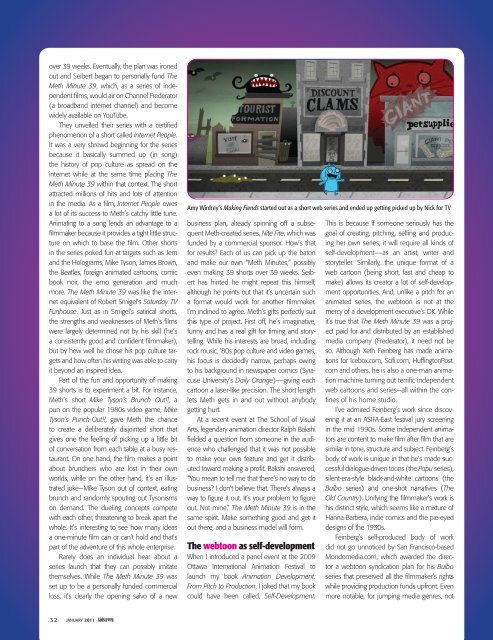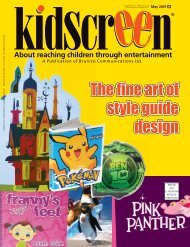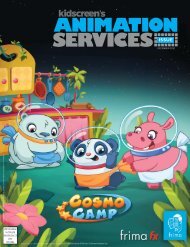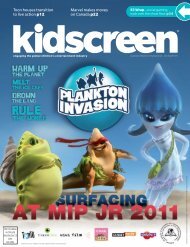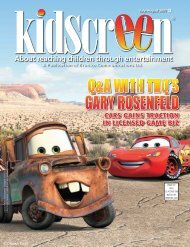Create successful ePaper yourself
Turn your PDF publications into a flip-book with our unique Google optimized e-Paper software.
over 39 weeks. Eventually, the plan was ironed<br />
out and Seibert began to personally fund The<br />
Meth Minute 39, which, as a series of independent<br />
fi lms, would air on Channel Frederator<br />
(a broadband internet channel) and become<br />
widely available on YouTube.<br />
They unveiled their series with a certifi ed<br />
phenomenon of a short called Internet People.<br />
It was a very shrewd beginning for the series<br />
because it basically summed up (in song)<br />
the history of pop culture as spread on the<br />
internet while at the same time placing The<br />
Meth Minute 39 within that context. The short<br />
attracted millions of hits and lots of attention<br />
in the media. As a fi lm, Internet People owes<br />
a lot of its success to Meth’s catchy little tune.<br />
Animating to a song lends an advantage to a<br />
fi lmmaker because it provides a tight little structure<br />
on which to base the fi lm. Other shorts<br />
in the series poked fun at targets such as Jem<br />
and the Holograms, Mike Tyson, James Brown,<br />
the Beatles, foreign animated cartoons, comic<br />
book noir, the emo generation and much<br />
more. The Meth Minute 39 was like the internet<br />
equivalent of Robert Smigel’s Saturday TV<br />
Funhouse. Just as in Smigel’s satirical shorts,<br />
the strengths and weaknesses of Meth’s fi lms<br />
were largely determined not by his skill (he’s<br />
a consistently good and confi dent fi lmmaker),<br />
but by how well he chose his pop culture targets<br />
and how often his writing was able to carry<br />
it beyond an inspired idea.<br />
Part of the fun and opportunity of making<br />
39 shorts is to experiment a bit. For instance,<br />
Meth’s short Mike Tyson’s Brunch Out!!, a<br />
pun on the popular 1980s video game, Mike<br />
Tyson’s Punch-Out!!, gave Meth the chance<br />
to create a deliberately disjointed short that<br />
gives one the feeling of picking up a little bit<br />
of conversation from each table at a busy restaurant.<br />
On one hand, the fi lm makes a point<br />
about brunchers who are lost in their own<br />
worlds, while on the other hand, it’s an illustrated<br />
joke—Mike Tyson out of context, eating<br />
brunch and randomly spouting out Tysonisms<br />
on demand. The dueling concepts compete<br />
with each other, threatening to break apart the<br />
whole. It’s interesting to see how many ideas<br />
a one-minute fi lm can or can’t hold and that’s<br />
part of the adventure of this whole enterprise.<br />
Rarely does an individual hear about a<br />
series launch that they can possibly imitate<br />
themselves. While The Meth Minute 39 was<br />
set up to be a personally funded commercial<br />
loss, it’s clearly the opening salvo of a new<br />
32 JANUARY 2011<br />
Amy Winfrey’s Making Fiends started out as a short web series and ended up getting picked up by Nick for TV<br />
business plan, already spinning off a subsequent<br />
Meth-created series, Nite Fite, which was<br />
funded by a commercial sponsor. How’s that<br />
for results? Each of us can pick up the baton<br />
and make our own “Meth Minutes,” possibly<br />
even making 39 shorts over 39 weeks. Seibert<br />
has hinted he might repeat this himself,<br />
although he points out that it’s uncertain such<br />
a format would work for another fi lmmaker.<br />
I’m inclined to agree. Meth’s gifts perfectly suit<br />
this type of project. First off, he’s imaginative,<br />
funny and has a real gift for timing and storytelling.<br />
While his interests are broad, including<br />
rock music, ‘80s pop culture and video games,<br />
his focus is decidedly narrow, perhaps owing<br />
to his background in newspaper comics (Syracuse<br />
University’s Daily Orange)––giving each<br />
cartoon a laser-like precision. The short length<br />
lets Meth gets in and out without anybody<br />
getting hurt.<br />
At a recent event at The School of Visual<br />
Arts, legendary animation director Ralph Bakshi<br />
fi elded a question from someone in the audience<br />
who challenged that it was not possible<br />
to make your own feature and get it distributed<br />
toward making a profi t. Bakshi answered,<br />
“You mean to tell me that there’s no way to do<br />
business? I don’t believe that. There’s always a<br />
way to fi gure it out. It’s your problem to fi gure<br />
out. Not mine.” The Meth Minute 39 is in the<br />
same spirit. Make something good and get it<br />
out there, and a business model will form.<br />
The webtoon as self-development<br />
When I introduced a panel event at the 2009<br />
Ottawa International Animation Festival to<br />
launch my book Animation Development:<br />
From Pitch to Production, I joked that my book<br />
could have been called, Self-Development.<br />
This is because if someone seriously has the<br />
goal of creating, pitching, selling and producing<br />
her own series, it will require all kinds of<br />
self-development––as an artist, writer and<br />
storyteller. Similarly, the unique format of a<br />
web cartoon (being short, fast and cheap to<br />
make) allows its creator a lot of self-development<br />
opportunities. And, unlike a pitch for an<br />
animated series, the webtoon is not at the<br />
mercy of a development executive’s OK. While<br />
it’s true that The Meth Minute 39 was a project<br />
paid for and distributed by an established<br />
media company (Frederator), it need not be<br />
so. Although Xeth Feinberg has made animations<br />
for Icebox.com, Scifi .com, Huffi ngtonPost.<br />
com and others, he is also a one-man animation<br />
machine turning out terrifi c independent<br />
web cartoons and series—all within the confi<br />
nes of his home studio.<br />
I’ve admired Feinberg’s work since discovering<br />
it at an ASIFA-East festival jury screening<br />
in the mid 1990s. Some independent animators<br />
are content to make fi lm after fi lm that are<br />
similar in tone, structure and subject. Feinberg’s<br />
body of work is unique in that he’s made successful<br />
dialogue-driven toons (the Papu series),<br />
silent-era-style black-and-white cartoons (the<br />
Bulbo series) and one-shot narratives (The<br />
Old Country). Unifying the fi lmmaker’s work is<br />
his distinct style, which seems like a mixture of<br />
Hanna-Barbera, indie comics and the pie-eyed<br />
designs of the 1930s.<br />
Feinberg’s self-produced body of work<br />
did not go unnoticed by San Francisco-based<br />
Mondomedia.com, which awarded the director<br />
a webtoon syndication plan for his Bulbo<br />
series that preserved all the fi lmmaker’s rights<br />
while providing production funds upfront. Even<br />
more notable, for jumping media genres, not


